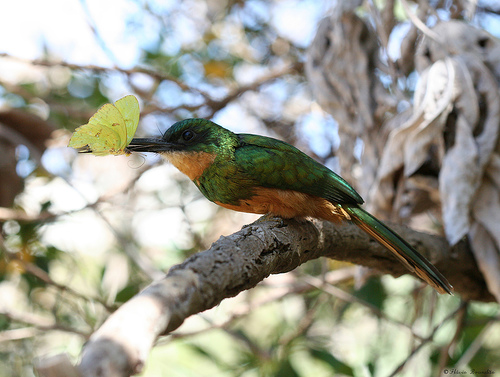Batesian Copycats and Mullerian Mimics
Biology 342 Fall 08
Marisa Mirviss and Molly Radany
Ontogeny of Mimicry
Most mimicry signals develop in the same way that other physiological traits develop; selection pressure is practically the only factor in the process. This makes sense when one looks at the mechanisms of mimicry, both Batesian and Mullerian: the helioconius butterfly doesn't realize that it is a mimic; it's color develops in the same way that the color of a non-mimic butterfly does, and it is selection only that alters the adaptive value of the mechanism, not the behavior per se of the animal.
However, there are mechanisms of mimicry that seemt to involve the active behavior of the individual. For instance, it has been observed that flight patterns are an indication of butterfly palatability: "Butterflies that fly slowly are unpalatable, while butterflies that fly quickly are palatable." [1] This can still be attributed as a secondary adaptation to the influence of predatory response as a selection pressure since a butterfly that is less likely to be eaten can spend less time being fast to avoid predation and more time on other activities that may increase its reproductive success.
Ontogeny of Predatory Response
Many mimics, both Batesian and Mullerian alike, would be out of luck if the local predators didn't fall for their ruse. It is beneficial and often essential for the predators themselves to understand the signals being sent by the model and react to them appropriately. This section is all about the behavioral development of the responses of mimics' predators, and why the bird that eats the Hawk Moth caterpillar doesn't declare:
Hey, you're not a snake!
The success of a mimic in avoiding predation relies entirely upon the how effectively the warning signal is recieved by the predator. It has been observed that most predators do not innately know that a mimic's signal conveys inedibility; most are preconditioned to quickly learn to recognize mimicry patterns, though the ease with which some predators do this may be traced to a genetic disposition toward learning to respect mimicry signals. [8]
The jacamar is a specialized predator; this tropical bird can recognize a bad tasting butterfly by sight, and consequently it altogether avoids the nasty experience of eating one. But how does it do this? A young, inexperienced jacamar will attempt to eat any butterfly it comes upon, but as soon as it tastes a bad butterfly it lets it go. The next time that species comes around, the juvenile will most often leave it alone. After a few attempts at eating nasty butterflies, the jacamar begins to categorize its potential prey by visual cues that it associates with yummy butterflies and not-so-yummy butterflies. Interestingly, the inedible butterflies are often less efficient at escape than the edible ones, which indicates that the response of specialized predators like the jacamar to the visual signals warning of their chemical defenses is enough to deter most attacks. [5]

A Rufus-tailed jacamar caught a presumably tasty meal.
(http://farm2.static.flickr.com/1415/1054927459_7f1ba821b0.jpg?v=0)